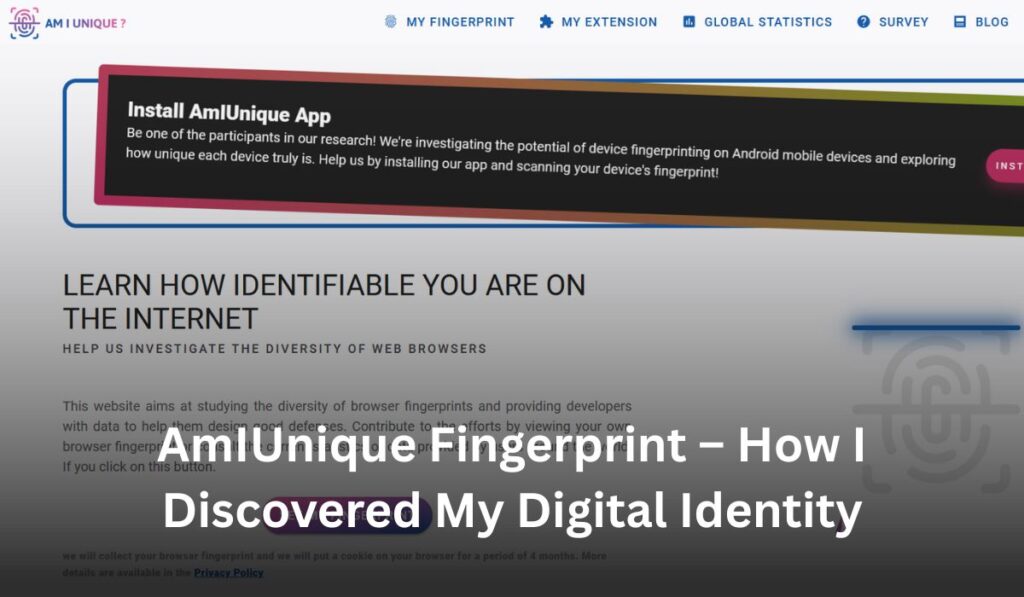
It was a quiet evening in late November when I stumbled upon something that would completely change how I saw the internet. I was sitting by my window, the soft hum of my laptop fan filling the silence. The rain tapped lightly on the glass, and the smell of freshly brewed coffee lingered in the room. I wasn’t searching for anything specific — just mindlessly browsing through random tech blogs. That’s when I came across a curious phrase: “browser fingerprinting.”
The words felt strange, almost eerie. Fingerprinting? Like the police kind?
Curiosity got the better of me. I clicked the link.
That’s how I discovered AmIUnique, a fascinating online project that claimed to show users how unique their digital identity really is — not through usernames or passwords, but through something invisible: their browser fingerprint.
At first, I laughed. “Fingerprint? My browser? Yeah, right.”
But as I scrolled through the page and hit “Test my browser,” I felt a chill down my spine.
Within seconds, a detailed report popped up — listing my operating system, screen resolution, installed fonts, plugins, timezone, browser version, language, even the hardware of my device. It was like someone had read my computer’s soul and presented it back to me.
I wasn’t being tracked by cookies or accounts. I was being recognized by who I was digitally — my unique combination of settings, hardware, and habits.
The Moment of Realization
I sat there for a few minutes, staring at the screen. My coffee had gone cold.
I had always considered myself privacy-conscious. I used incognito mode. I cleared cookies. I avoided logging into too many services. But this? This was different.
This wasn’t about what I shared. It was about what I was.
Every click, every site visit, every scroll — my browser left behind traces that identified me even when I thought I was “anonymous.”
And AmIUnique showed me that my setup was one in a million. Literally.
That realization hit me like a wave. The digital world I had once seen as limitless and open suddenly felt smaller, more personal, almost claustrophobic.
Understanding AmIUnique
For those who haven’t tried it yet, AmIUnique.org is a project developed by privacy researchers to help people understand browser fingerprinting.
Here’s how it works in simple terms:
When you visit a website, your browser automatically sends technical information — your screen size, your operating system, the fonts you have installed, your GPU (graphics card), your timezone, and even how your browser renders graphics and text.
Individually, these details don’t seem like much. But together, they form a digital fingerprint — a unique signature that can be used to recognize your device every time you go online.
So even if you delete cookies, switch to incognito, or use a VPN, your fingerprint might still reveal who you are.
That’s what AmIUnique helps you see — the invisible identity you carry every time you browse.
The Labyrinth of Data
After that evening, I went down a rabbit hole.
I read papers about fingerprinting techniques, scripts that detect canvas rendering, and methods that can even identify your computer through subtle differences in how your browser handles graphics or fonts.
It was both fascinating and terrifying.
I realized how every device on the internet has a digital personality, just like humans do. Some are loud and obvious — those with rare setups or outdated software. Others are quiet, blending in among millions.
But almost everyone can still be recognized with enough data.
The internet suddenly felt like a giant room filled with mirrors — each reflecting small fragments of my identity back at me.
The Emotional Side of Digital Exposure
That night, I couldn’t sleep.
There was this uneasy feeling — like I’d left my front door wide open without realizing it. My mind replayed all the times I’d browsed freely, assuming anonymity.
We often think of the digital world as intangible — as if it’s separate from us. But after exploring AmIUnique, I realized how intimately connected our online behavior is to who we are.
It made me rethink privacy — not as a technical setting, but as something deeply human.
I started noticing small things — like how ads seemed more targeted, or how websites remembered preferences I never saved. I began using privacy browsers, VPNs, and extensions that randomize my fingerprint.
But even then, a strange truth settled in: there’s no such thing as complete invisibility online.
And maybe that’s okay.
Lessons Learned – You Can’t Hide, But You Can Be Aware
AmIUnique didn’t scare me away from the internet. It made me more conscious.
Here’s what I learned along the way:
- Awareness is the first layer of privacy.
Most people have no idea their browser gives away so much. Simply knowing this changes how you interact online. - Technology isn’t the enemy.
Fingerprinting wasn’t created to spy on you — it began as a way to prevent fraud, detect bots, and improve user experience. The problem arises when it’s used without transparency. - You can take control — to an extent.
Using browsers like Firefox or Brave, enabling anti-fingerprinting modes, and turning off unnecessary plugins can make you less identifiable. - Data isn’t evil; misuse is.
The internet runs on data. The challenge is ensuring it’s collected ethically and used responsibly. - Privacy is a journey, not a destination.
You’ll never be 100% private. But you can get closer by being intentional about what you share and how you browse.
How AmIUnique Works Behind the Scenes
For those curious about the technical side, AmIUnique gathers non-personal browser data and compares it with a massive database of other users’ fingerprints.
When you visit the site, it collects data like:
- User-agent (browser + OS details)
- Screen resolution
- Timezone
- Language preferences
- Installed plugins and fonts
- Canvas and WebGL rendering details
- Hardware information like CPU/GPU
Then, it generates a hash — a unique code representing your fingerprint.
This fingerprint is then compared with millions of others to determine how unique your setup is.
If you’re using a rare device configuration — say, a Linux distro with a specific screen size — you’re more identifiable. If you’re using a common setup like Chrome on Windows with default settings, you blend in better.
The site doesn’t store your data permanently or use it for advertising. It’s purely educational — a mirror reflecting your digital identity.
The Day I Shared It with Friends
A few days later, I shared AmIUnique with my friends over coffee.
Their reactions were priceless.
One of them laughed nervously and said, “Bro, I thought incognito meant no one could see me!”
Another stared at the screen and whispered, “This is creepy…”
We spent the next hour experimenting — changing browsers, using extensions, even switching devices — and each time, the fingerprint changed slightly, but not enough to completely disappear.
It felt like we were scientists in a digital lab, testing how invisible we could get. Spoiler: not very.
But something interesting happened — the conversation shifted from fear to understanding.
We talked about consent, data ownership, and how much of ourselves we unknowingly give away online.
That’s when I realized — privacy education doesn’t have to be technical. It’s about making people feel connected to the issue. Because only when it feels personal do we start to care.
Why AmIUnique Matters Today
In an age where artificial intelligence, targeted ads, and personalized content dominate our screens, knowing how your device is identified is more important than ever.
Every major tech company uses some form of fingerprinting — for fraud detection, analytics, or personalization.
But the real value of AmIUnique is transparency.
It doesn’t collect data to sell you something. It shows you what others could collect.
That awareness gives you power — the power to choose which technologies you trust, what data you share, and when to say no.
My Digital Detox
After my deep dive into digital fingerprints, I took a small step back.
For a week, I tried to reduce my online presence — fewer logins, no social media, only essential browsing.
It was liberating. The noise faded. I started to notice real-world details again — the sound of birds in the morning, the warmth of sunlight on my face, the taste of food unaccompanied by scrolling.
It reminded me that while technology defines so much of modern life, it doesn’t define us.
We still have the power to disconnect, to choose silence, to be unseen — at least for a while.
The Reflection
Looking back, discovering AmIUnique wasn’t just about privacy. It was about self-awareness.
It taught me that identity exists both offline and online — and both deserve respect and protection.
We spend years learning how to protect our physical selves — locking doors, securing valuables, guarding personal information. But our digital selves? We often leave them unguarded, trusting an invisible system.
AmIUnique is that wake-up call.
It doesn’t tell you to hide. It tells you to know yourself digitally — to understand the footprints you leave behind and to take ownership of them.
Because awareness is power.
Final Thought – Growth and Resilience
Today, I see technology differently. I don’t fear it; I respect it.
The internet isn’t a villain — it’s a reflection of humanity itself: curious, flawed, beautiful, and endlessly evolving.
And just like in life, awareness is what helps us grow.
We can’t erase every trace we leave behind — but we can walk with intention.
That’s what resilience in the digital age looks like: not hiding from technology, but learning to live consciously within it.
So, next time you open your browser, remember — somewhere in that hum of code and pixels, your digital fingerprint is saying, “This is me.”
And that’s not something to fear. It’s something to understand.






